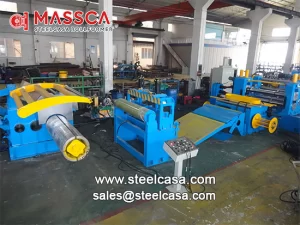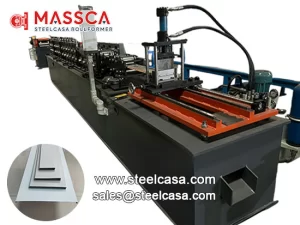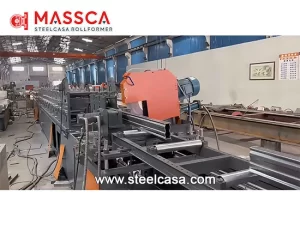What is a roll forming machine?
A roll forming machine, commonly known as a metal forming machine, shapes specific profiles out of long strips of metal, typically coiled steel. To bend the metal to the desired shape, the machine is designed with a specific cross-sectional profile for the piece. In addition to roll forming, these machines perform various metalworking tasks, including material cutting and hole punching.
For the most part, roll forming machines operate continuously. The material is fed into the machine, and it passes through a series of stages, concluding with the production of the final product.
How a roll forming machine operates
In a roll forming machine, metal is bent at room temperature using a series of stations where fixed rollers guide the metal and create the necessary bends. Each set of rollers bends the metal further than the previous station as the metal strip travels through the roll forming machine.
This advanced method of bending the metal ensures the correct cross-sectional shape is achieved while maintaining the cross-sectional area of the workpiece. Roll forming machines are an excellent choice for manufacturing large quantities or very long pieces due to their operating speeds, which typically range from 30 to 600 feet per minute.
If a specific part requires precise finishing work, roll forming machines excel at creating it. In most cases, the finished product exhibits an excellent finish and fine details, depending on the material being formed. Engineering machines are available for sale for this purpose.
The process and fundamentals of roll forming
A basic roll forming machine consists of a line that can be divided into four major sections. The initial section is the entry point, where the material is loaded. The material is either inserted in sheet form or fed from a continuous coil. The next section is the station rollers, where the actual roll forming process occurs. The metal takes on its shape as it passes through this section. Station rollers not only shape the metal but also provide the main driving force for the machine.
The next section of a basic roll forming machine is the cut-off press. Here, the metal is cut to a predetermined length. Flying die cut-off techniques are common in this stage due to the machine’s high operating speed and its continuous operation. The final section is the exit station, where the finished part exits the machine onto a roller conveyor or table and is manually moved.
Conclusion
Roll forming is a versatile process that can be adapted to projects of varying durations. Additionally, roll forming machines produce precise and uniform parts.





